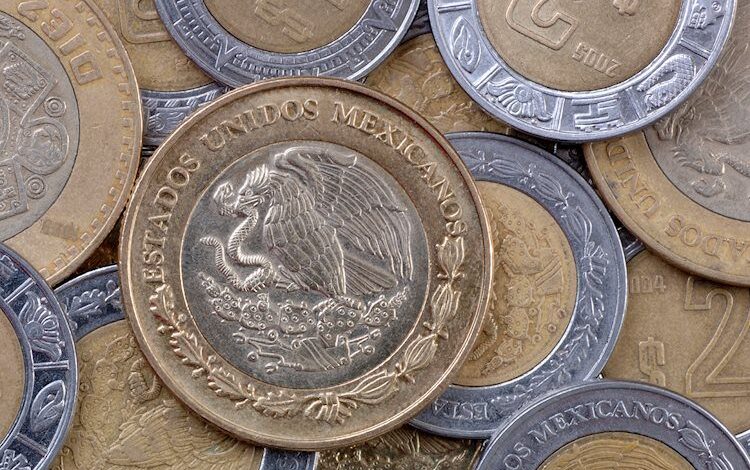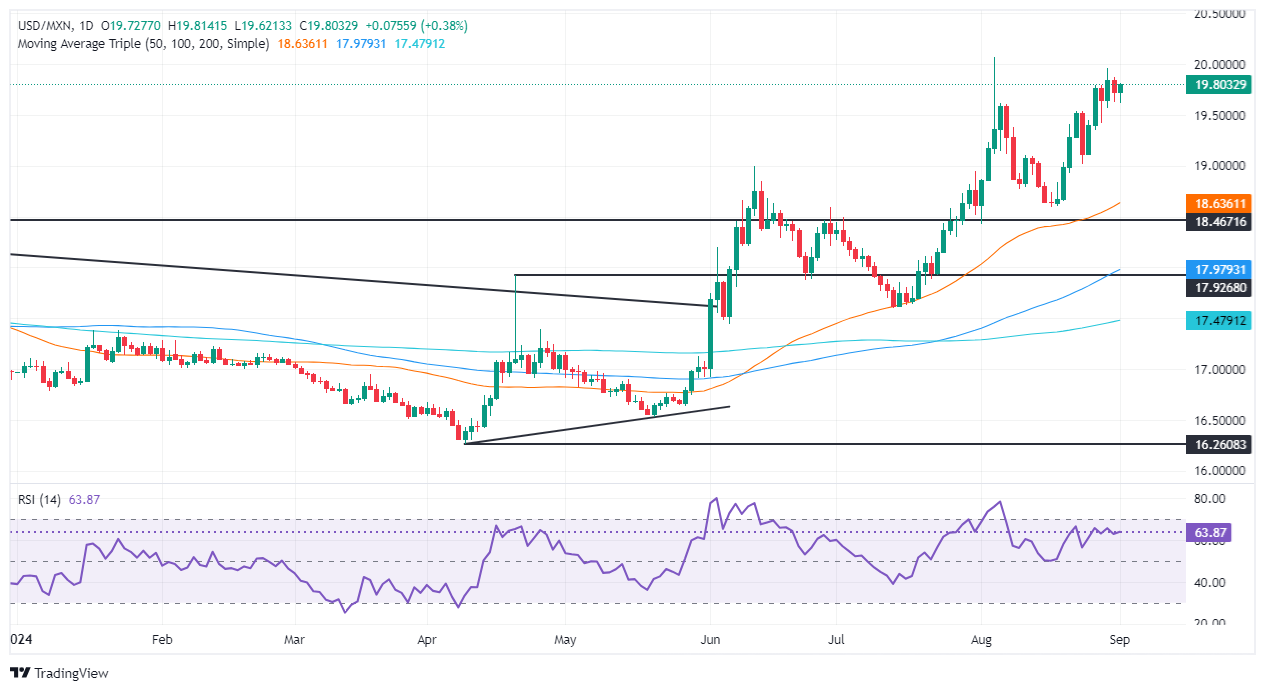Mexican Peso falls as Congress discusses judiciary reform

- Mexican Peso weakens as USD/MXN climbs on judiciary reform concerns after new Congress convenes.
- Mexico’s Business Confidence improves slightly in August, while Manufacturing PMI hits a two-year low, indicating sectoral challenges.
- S&P Global cites weak sales, competition from China, and highway insecurity as key issues for Mexican manufacturers.
The Mexican Peso begins September on a lower note, tumbling more than 0.50% amid renewed fears that the judiciary reform is a go and could be approved during the first week of the new Mexican Congress that took office on September 1. The USD/MXN trades at 19.80 after jumping from a daily low of 19.60.
Mexico’s economic docket featured Business Confidence in August, which improved slightly compared to July’s data. In the meantime, business activity in August, as measured by the S&P Global Manufacturing PMI, slumped to its lowest level in two years, the agency revealed.
Pollyanna De Lima, Economics Associate Director at S&P Global Market Intelligence, commented: “August proved to be another difficult month for Mexican manufacturers, with firms trimming output, employment, and stocks due to subdued sales in both the domestic and international markets. Total order book volumes dropped to the greatest extent in two years, boding ill for near-term production prospects.”
De Lima added that companies became concerned about “intense competition from China and highway insecurity.”
At the same time, Mexican Business Confidence improved, driven by a minimal improvement in investment propensity, revealed the Instituto Nacional de Estadistica Geografia e Informatica (INEGI).
Across the border, Wall Street remains closed due to the observance of the Labor Day holiday. Activities will resume on Tuesday, though traders are eyeing the release of employment data on Friday. Nonfarm Payrolls (NFP) for August are expected to exceed July’s data.
In the meantime, the latest inflation report by the US Bureau of Economic Analysis (BEA) revealed that the Core Personal Consumption Expenditures Price Index (Fed), the Fed’s preferred inflation gauge, remained unchanged at around 2.5% YoY.
Daily digest market movers: Mexican Peso on the defensive amid political turmoil
- Business Confidence improved from 53 to 53.2, expanding for the third straight month, yet it remains below the highest level reached in January of 54.4.
- S&P Global Manufacturing PMI contracted for the second consecutive month, from 49.6 to 48.5, hinting that Mexico’s economic slowdown is more profound than expected.
- Most banks expect the Bank of Mexico (Banxico) to reduce rates by at least 50 basis points (bps) for the remainder of 2024. This would pressure the Mexican currency, which has already depreciated 15.38% year to date (YTD).
- USD/MXN rally extends on fears of an approval of the judiciary reform, sparking a flight of safety to the US Dollar.
- Regarding this, a judge granted a stay over the weekend to prevent debate on the proposal. The initiative has sparked a strike in the judicial sector, strained relations with the United States, and shaken local markets amid widespread doubts it generates.
- Mexican President Andres Manuel Lopez Obrador’s decision to pause relations with the US and Canadian ambassadors this week will continue to weigh on the Mexican Peso.
- US Nonfarm Payrolls in August are expected to grow from 114K to 163K, while the Unemployment Rate is foreseen ticking lower from 4.3% to 4.2%.
- Data from the Chicago Board of Trade (CBOT) suggests the Fed will cut at least 96.5 basis points (bps), according to the fed funds rate futures contract for December 2024.
Technical outlook: Mexican Peso weakens as USD/MXN climbs above 19.70
The USD/MXN uptrend remains in place, with the pair consolidating within the 19.50-20.00 range for the first trading day in September. Momentum shows further upside as the Relative Strength Index (RSI) is bullish and shifted flat from being tilted to the downside.
If USD/MXN buyers clear the 20.00 figure, there are plenty of additional topside targets. The next resistance would be the YTD high at 20.22, followed by the September 28, 2022, daily high at 20.57. If those two levels are surrendered, the next stop would be August 2, 2022, swing high at 20.82, ahead of 21.00.
On further USD/MXN weakness, the first support would be 19.50. A breach of the latter will expose the August 23 swing low of 19.02 before giving way for sellers eyeing a test of the 50-day Simple Moving Average (SMA) at 18.62.
Risk sentiment FAQs
In the world of financial jargon the two widely used terms “risk-on” and “risk off” refer to the level of risk that investors are willing to stomach during the period referenced. In a “risk-on” market, investors are optimistic about the future and more willing to buy risky assets. In a “risk-off” market investors start to ‘play it safe’ because they are worried about the future, and therefore buy less risky assets that are more certain of bringing a return, even if it is relatively modest.
Typically, during periods of “risk-on”, stock markets will rise, most commodities – except Gold – will also gain in value, since they benefit from a positive growth outlook. The currencies of nations that are heavy commodity exporters strengthen because of increased demand, and Cryptocurrencies rise. In a “risk-off” market, Bonds go up – especially major government Bonds – Gold shines, and safe-haven currencies such as the Japanese Yen, Swiss Franc and US Dollar all benefit.
The Australian Dollar (AUD), the Canadian Dollar (CAD), the New Zealand Dollar (NZD) and minor FX like the Ruble (RUB) and the South African Rand (ZAR), all tend to rise in markets that are “risk-on”. This is because the economies of these currencies are heavily reliant on commodity exports for growth, and commodities tend to rise in price during risk-on periods. This is because investors foresee greater demand for raw materials in the future due to heightened economic activity.
The major currencies that tend to rise during periods of “risk-off” are the US Dollar (USD), the Japanese Yen (JPY) and the Swiss Franc (CHF). The US Dollar, because it is the world’s reserve currency, and because in times of crisis investors buy US government debt, which is seen as safe because the largest economy in the world is unlikely to default. The Yen, from increased demand for Japanese government bonds, because a high proportion are held by domestic investors who are unlikely to dump them – even in a crisis. The Swiss Franc, because strict Swiss banking laws offer investors enhanced capital protection.
Information on these pages contains forward-looking statements that involve risks and uncertainties. Markets and instruments profiled on this page are for informational purposes only and should not in any way come across as a recommendation to buy or sell in these assets. You should do your own thorough research before making any investment decisions. FXStreet does not in any way guarantee that this information is free from mistakes, errors, or material misstatements. It also does not guarantee that this information is of a timely nature. Investing in Open Markets involves a great deal of risk, including the loss of all or a portion of your investment, as well as emotional distress. All risks, losses and costs associated with investing, including total loss of principal, are your responsibility. The views and opinions expressed in this article are those of the authors and do not necessarily reflect the official policy or position of FXStreet nor its advertisers. The author will not be held responsible for information that is found at the end of links posted on this page.
If not otherwise explicitly mentioned in the body of the article, at the time of writing, the author has no position in any stock mentioned in this article and no business relationship with any company mentioned. The author has not received compensation for writing this article, other than from FXStreet.
FXStreet and the author do not provide personalized recommendations. The author makes no representations as to the accuracy, completeness, or suitability of this information. FXStreet and the author will not be liable for any errors, omissions or any losses, injuries or damages arising from this information and its display or use. Errors and omissions excepted.
The author and FXStreet are not registered investment advisors and nothing in this article is intended to be investment advice.




